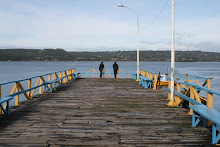
We flew in on LAN Chile, the only airline that services the one strip airport on the island. A local told us (not necesarily true) that LAN's contract with the airstrip was just up and as of recently they were sending in a flight everyday, which would account for our dope discount. The sudden increase in flights to the island is to prevent other airlines from sending in flights, thus robbing LAN of its monopoly on the island. It seems to me that this "undiscovered" place will soon be flooded with tourists and with five star hotels, but for now it is a sleepy island in the south Pacific balancing a Polynesian and Chilean lifestyle/culture/language.
The week started off simple and from there became more 'baller.' The first day Molly and I rented bicycles and took the northeast route out to Rano Raraku, the moais quarry. On the way we saw a handfull of fallen moais, their giant noses in the dirt along the coast and sometimes a restored platform with standing moais, their backs to the ocean facing the interior of the island. Most of the moais on the island were carved from the volcanic crater at Rano Raruko and hundreds are still buried in the slopes of the volcano.

The next day we hiked up to Orongo, the old village on the other side of the island on the crater of Rano Kau, the volcano at the opposite side of the island. The village is parcially restored and views three small islets seen from over giant cliffs. We went up on a rainy day and say a ton of rainbows coming out the water and the volcanic crater.
On Sunday we took a tour and went back to some of the sites we had already gone to on our own and got a great history lesson from a local. The barren landscape of the island is startling and even more so when we learned that all the trees were cut down in order to transport the giant moais to their resting places. The Rapa Nui people had become so preocupied with the moais that they ignored the obvious damage they were doing to their home. Without trees they could not build houses nor boats. The land became eroded, the rivers disapeared, and the animals began to die. A once prosperous civilization had fallen to its knees because of their preocupation with building bigger and better statues. The largest moais, still partially carved into the stone mountain face at Rano Raraku is 21 meters tall (69 ft). Without trees they could not transport the moais from the quarry and work stopped suddenly when sustaining life became an immenent preocupation.
Renting a car is a great way to explore the island. We explored some sweet caves with out Suziki Grand Vitara. In the middle of the island are a few giant lava tube caves and on the coast, Dos Ventanas, has a small entrance but once inside there are two windows overlooking the sea from large cliffs.

The last day on the island we went self contained breather appartus (SCUBA) diving. I had never gone before and it was amazing. Molly is certified and apparantly was not impressed by the safety regulations of the company, afterwards she told me that she was instructed never to dive with a company that takes first-timers underwater...However, despite being dragged, literally, by a guide through coral and schools of tropical fish, I survived and definately can see myself getting licensed in the future.
Easter Island is an incredible place that I see changing very quickly. Just recently a 5 star hotel, Explora, was built on the island and construction is under way for more giant hotels. I can easily see the place turn into a top destination spot quickly for the beautifully clear waters, tropical climate, beaches, seafood, surfing, and archiological significance. We were still able to go some of the archeological sites without any other people around. To be alone with seven 4 meter moais standing over your head is an incredible feeling and one that may not last much longer. Just this May the first signs were put up warning visitors not to climb on the ahu and moais. I expect that in few years time the restrictions will be more stringent and the atmosphere changed. We met a guy at our campsite who arrived in December of last year and decided to stay when he learned that a solar eclipse would be visible in 2010 from the island. Trying to find a bed on the island for the event is nearly impossible but I would highly recommend it. He told me he would send me a picture for the extra food we gave him but frankly, I'm not holding my breath.

Up next, Cuzco, Peru and Machu Picchu.







No comments:
Post a Comment